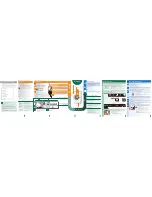
10
Warm or hot water is not hot enough.
Washer won't spin.
Residue left in drum.
Water collects in bleach and fabric softener
compartments.
WATER
Wash load too wet after spin.
Water in washer does not drain or drains
slowly.
Water does not enter washer or it enters
slowly.
Water leaks.
Incorrect wash and rinse temperatures.
Water is entering washer but tub does not
fill.
• Electrical power cord may not be plugged in or connection may be loose. Make sure plug fits tightly
in wall outlet.
• House fuse blown, circuit breaker tripped, or a power outage has occurred. Reset circuit breaker
or replace fuse. Do not increase fuse capacity. If problem is a circuit overload, have it corrected
by a qualified electrician. If problem is a power outage, call local electric company.
• Water supply faucets are not turned on. Turn on water supply faucets.
• Cycle selector is not in correct position. Move indicator clockwise slightly. Pull out knob.
• Motor is overheated. Washer motor will stop if it becomes overheated. It will automatically restart
after a cool down period of up to 30 minutes (if washer has not been manually turned off).
• Washer door is not completely closed. Close door completely.
• Load is too small. Add 1 or 2 similar items to help balance the load.
• Heavily soiled items. Wipe drum with a nonabrasive household cleanser, then rinse. Shake or brush
excess dirt and sand from items before washing.
• Dispenser drawer open. Drawer should be completely closed for laundry additive to dispense.
• This is a result of the siphoning action and is part of the normal operation of the washer. Water
may be removed by removing the dispenser drawer (see Page 9, Figures 1 and 2) and draining water
into the empty drum or sink.
• Washer is overloaded. Do not overload washer. See
Washing Procedures.
• Load is too small. Add 1 or 2 similar items to help balance the load.
• Load is out of balance. Rearrange load to allow proper spinning.
• Drain hose is kinked. Straighten drain hose.
• Water supply is not adequate in area. Check another faucet in the house. Wait until water supply
and pressure increase.
• Water supply faucets are not completely open. Fully open hot and cold faucets.
• Water is being used elsewhere in the house. Water pressure must be at least 30 psi (260 kPa). Avoid
running water elsewhere while washer is filling.
• Water inlet hoses are kinked. Straighten hoses.
• Hot water heater is set too low or is a distance from washer. Measure hot water temperature
at nearby faucet with candy or meat thermometer. Water temperature should be at least 120°F
(49°C). Adjust water heater as necessary.
• Hot water is being used elsewhere in the house. Avoid using hot water elsewhere before or during
washer use. There may not be enough hot water available for proper cleaning. If problem persists,
your hot water system may be unable to support more than 1 use at a time.
• Drain hose is kinked or clogged. Clean and straighten the drain hose.
• House drain pipes are clogged. Unclog drain pipes. Contact plumber if necessary.
• Fill hose connection is loose at faucet or washer. Check and tighten hose connections. Install rubber
sealing washers provided.
• Oversudsing.Use less detergent.
• Dispenser drawer is open. Close drawer when washer is operating..
• Hot and cold water hoses are connected to wrong supply faucets. Connect hot water hose to hot
water faucet and cold water hose to cold water faucet.
• Drain hose standpipe is incorrect height. Standpipe must be a minimum of 23.6" (60 cm) high to
prevent siphoning. See INSTALLATION INSTRUCTIONS.
OPERATING
Avoid Service Checklist
Before calling for service, review this list. It may save both time and expense. The list includes common concerns that are not the result of defective
workmanship or materials in this washer.
POSSIBLE CAUSE / SOLUTION
OCCURRENCE
"Clicking" noise.
High pitch "jet engine" noise.
Rattling and clanking noise.
Squealing sound or hot rubber odor.
Thumping sound.
Vibrating noise.
Washer does not start.
NOISE
• A normal sound made by the timer.
• A certain amount of motor whine is normal during the spin cycle.
• Foreign objects such as coins or safety pins may be in drum or pump. Stop washer and check drum.
If noise continues after washer is restarted, objects may be in pump. Call your authorized servicer.
• Belt buckles and metal fasteners are hitting wash drum. To prevent unnecessary noise and damage
to drum, fasten fasteners and turn items inside out.
• Washer is overloaded. Do not overload washer. Stop washer and reduce load.
• Heavy wash loads may produce a thumping sound. This is usually normal. If sound continues, washer
is probably out of balance. Stop washer and redistribute wash load.
• Washer is not resting firmly on floor. Move washer so it rests firmly on floor. Adjust leveling legs.
See INSTALLATION INSTRUCTIONS for details.
• Shipping bolts and foam block have not been removed during installation. See INSTALLATION
INSTRUCTIONS for removing shipping bolts and foam block.
• Wash load unevenly distributed in drum. Stop washer and rearrange wash load.
Laundry additives didn't dispense.





























